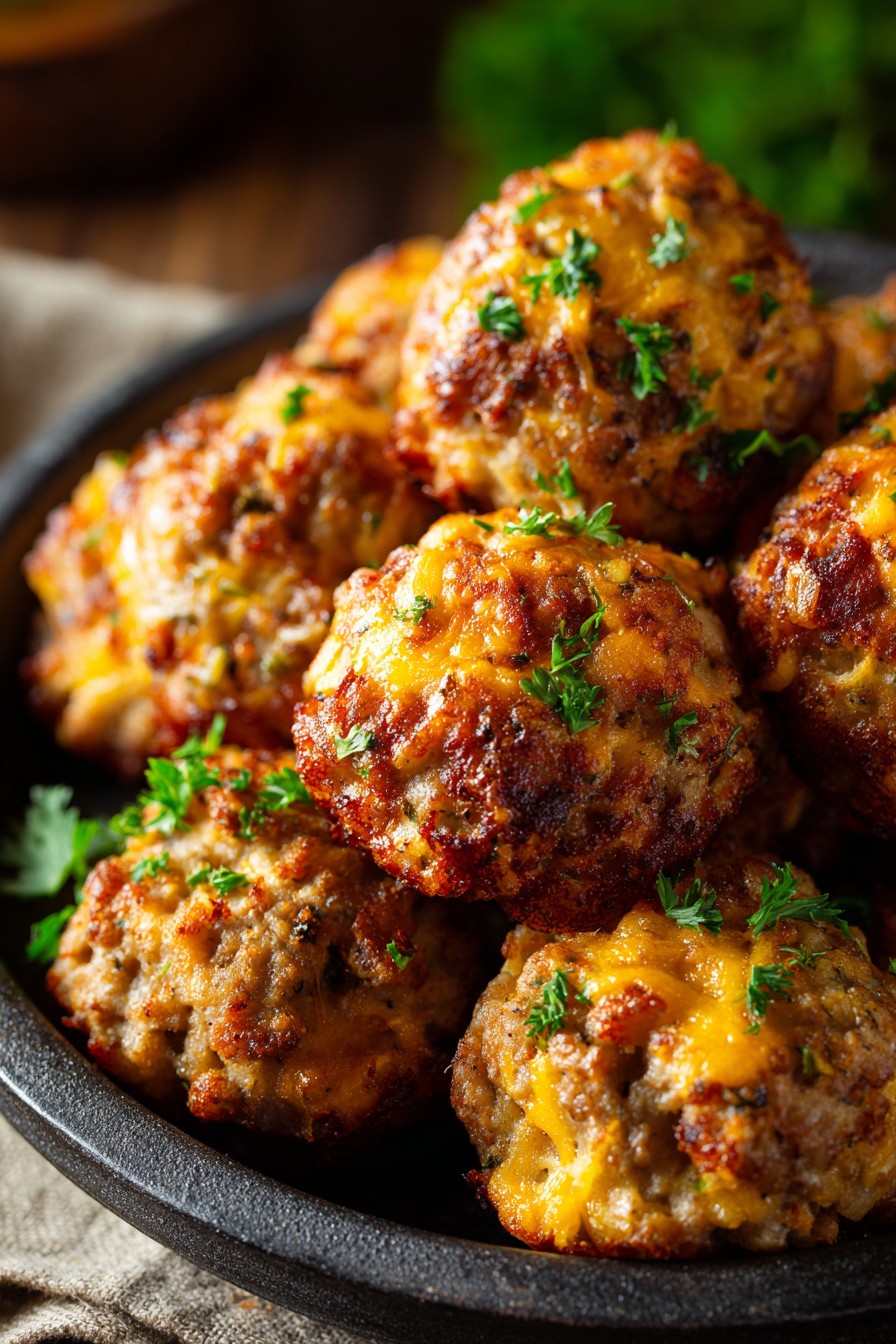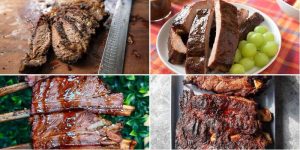You’re about to discover how these turkey sausage balls transform ordinary ingredients into extraordinary nutrition. Year-round favorites, these savory morsels deliver exceptional protein content while maintaining a satisfying texture that appeals to both health-conscious adults and picky eaters alike. Their versatility makes them perfect for meal prep, quick snacks, or elegant party appetizers that won’t derail your nutritional goals.
Why This Recipe Works
- Turkey sausage provides lean protein with significantly less saturated fat than traditional pork sausage, supporting heart health while delivering robust flavor that satisfies savory cravings without excessive sodium or preservatives found in many processed alternatives.
- The combination of whole wheat baking mix and sharp cheddar creates a perfect nutritional balance, offering complex carbohydrates for sustained energy alongside calcium and protein from quality dairy, while the cheese’s natural umami enhances flavor without needing additional salt.
- These sausage balls freeze exceptionally well, making them ideal for busy households seeking convenient, healthy options that can be prepared in advance and reheated without sacrificing texture or nutritional integrity.
- With only six simple ingredients, this recipe minimizes processed components while maximizing nutritional density, providing a clean-label option that fits various dietary approaches from weight management to athletic performance nutrition.
- The small, uniform size ensures consistent cooking and portion control, allowing for precise calorie management while creating perfect finger food for social gatherings or quick protein boosts between meals.
Ingredients
- 1 pound ground turkey sausage (mild or spicy variety, casings removed if using linked sausage)
- 2 cups whole wheat baking mix (such as whole wheat Bisquick alternative)
- 2 cups shredded sharp cheddar cheese (freshly grated from block preferred)
- 1/2 cup whole milk (or unsweetened almond milk for dairy-free option)
- 1/4 cup finely chopped fresh parsley
- 1/2 teaspoon garlic powder
- 1/4 teaspoon black pepper (freshly ground)
Equipment Needed
- Large mixing bowl
- Baking sheets (2 standard size)
- Parchment paper or silicone baking mats
- Measuring cups and spoons
- Cookie scoop (1-inch size recommended)
- Wire cooling rack
Instructions

Prepare Your Ingredients and Workspace
Begin by preheating your oven to 375°F and lining two baking sheets with parchment paper or silicone baking mats to prevent sticking and ensure even browning. Measure out your two cups of whole wheat baking mix, being careful not to pack it down in the measuring cup for accurate proportions. Freshly grate your two cups of sharp cheddar cheese from a block rather than using pre-shredded varieties, as the anti-caking agents in pre-shredded cheese can affect texture and melting properties. Finely chop your quarter cup of fresh parsley, removing any tough stems, and combine it with the half teaspoon of garlic powder and quarter teaspoon of freshly ground black pepper in a small bowl. Having all ingredients measured and prepared before mixing ensures consistent results and prevents overworking the dough. Pro Tip: Chill your mixing bowl in the refrigerator for 15 minutes before beginning to help keep the fat in the sausage from becoming too soft during handling.
Combine Dry Ingredients Thoroughly
In your large mixing bowl, add the two cups of whole wheat baking mix, two cups of freshly grated sharp cheddar cheese, and the herb-spice mixture containing the quarter cup of finely chopped fresh parsley, half teaspoon of garlic powder, and quarter teaspoon of black pepper. Use a fork or whisk to combine these dry ingredients thoroughly, ensuring the cheese and seasonings are evenly distributed throughout the baking mix. This step is crucial for consistent flavor in every sausage ball and prevents pockets of concentrated seasoning. The whole wheat baking mix provides complex carbohydrates and additional fiber compared to traditional white flour blends, while the sharp cheddar contributes both flavor and valuable calcium. Take approximately two minutes to achieve a uniform mixture, breaking up any clumps of cheese that may have stuck together during grating.
Incorporate Turkey Sausage and Milk
Form Uniform Sausage Balls
Using a one-inch cookie scoop or tablespoon measure, portion the sausage mixture into approximately 40 equal-sized balls, rolling each portion between your palms to create smooth, round shapes. Place the formed balls on your prepared baking sheets, spacing them about one inch apart to allow for even air circulation and browning. If the mixture feels too sticky, lightly dampen your hands with water between every few balls to prevent sticking without adding extra fat or flour. The consistent size ensures they cook at the same rate, preventing some from being undercooked while others become overbrowned. Pro Tip: For extra crispiness, gently flatten each ball slightly before baking to increase surface area contact with the hot baking sheet.
Bake to Golden Perfection
Place both baking sheets in your preheated 375°F oven, positioning one rack in the upper third and one in the lower third of the oven. Bake for 18-22 minutes, rotating the sheets halfway through cooking time to ensure even browning. The turkey sausage balls are done when they develop a golden brown exterior and reach an internal temperature of 165°F when tested with an instant-read thermometer. Avoid opening the oven door frequently during the first 15 minutes of baking to maintain consistent oven temperature for proper rise and texture development. The cheese should be visibly melted and bubbly around the edges, while the exterior develops a slight crispness that contrasts beautifully with the tender interior.
Cool and Serve Appropriately
Remove the baking sheets from the oven and immediately transfer the turkey sausage balls to a wire cooling rack using a spatula. Allow them to rest for at least 5-7 minutes before serving, as this resting period allows the proteins to set and the internal steam to redistribute, preventing them from falling apart. The internal temperature will continue to rise slightly during this resting period, ensuring food safety while developing optimal texture. Pro Tip: For extra crispiness, you can return the cooled sausage balls to a 400°F oven for 3-4 minutes just before serving to refresh their texture. Serve warm with your favorite healthy dipping sauces or enjoy them as a standalone protein-rich snack.
Tips and Tricks
For optimal texture and flavor development, consider using turkey sausage with different seasoning profiles to customize your nutritional approach. Mild Italian-style turkey sausage provides classic herb notes without excessive heat, while spicy varieties can boost metabolism through capsaicin content. If using unseasoned ground turkey, you’ll need to add approximately one teaspoon of Italian seasoning blend, half teaspoon of fennel seeds (lightly crushed), and quarter teaspoon of red pepper flakes to achieve similar flavor complexity. When measuring your whole wheat baking mix, use the spoon-and-level method rather than scooping directly from the container to prevent compacting too much flour into your measurement, which could result in dry, dense sausage balls.
The cheese selection significantly impacts both nutrition and texture. Sharp cheddar provides the strongest flavor with less volume needed, reducing overall fat content while maintaining cheesy satisfaction. For lactose-sensitive individuals, aged cheeses like Parmesan or Asiago contain minimal lactose while delivering intense flavor. If you prefer a dairy-free version, nutritional yeast combined with a small amount of dairy-free cream cheese can mimic the cheesy flavor and binding properties. When mixing your ingredients, pay attention to dough consistency—it should be moist enough to hold together when pressed but not sticky or wet. If the mixture seems too dry, add milk one tablespoon at a time; if too wet, add baking mix one tablespoon at a time until the proper consistency is achieved.
For meal prep efficiency, you can prepare the sausage ball mixture up to 24 hours in advance and store it covered in the refrigerator until ready to bake. The chilled dough often produces slightly taller, more uniform balls since the fat remains solid longer in the oven. When freezing unbaked sausage balls, arrange them in a single layer on a parchment-lined baking sheet and freeze until solid before transferring to airtight containers or freezer bags. This prevents them from sticking together and allows you to bake directly from frozen, adding 3-5 minutes to the cooking time. For baked sausage balls, cool completely before freezing in single layers separated by parchment paper to maintain individual portion integrity.
Recipe Variations
- For a Mediterranean twist, substitute the cheddar cheese with equal parts crumbled feta and grated Parmesan, replace the parsley with fresh oregano, and add two tablespoons of sun-dried tomatoes (chopped fine). The briny feta provides calcium with less fat than cheddar, while sun-dried tomatoes contribute lycopene and concentrated umami flavor that complements the turkey beautifully. Serve these with tzatziki sauce made from Greek yogurt for additional protein benefits.
- Create a breakfast-friendly version by using maple-flavored turkey sausage and replacing half the cheddar with pepper jack cheese for subtle heat. Add one tablespoon of pure maple syrup to the milk mixture and incorporate two tablespoons of finely chopped scallions. The natural sweetness from maple syrup provides quick energy without refined sugars, while scallions add prebiotic fiber and vitamin K. These pair wonderfully with scrambled eggs for a balanced morning meal.
- For a vegetable-packed option, reduce the baking mix to one and three-quarter cups and add one cup of finely grated zucchini (squeezed dry) and half cup of finely chopped spinach. The additional vegetables increase fiber content and add moisture while providing essential vitamins A and C. The green flecks throughout make these particularly appealing to children while secretly boosting their vegetable intake without altering the familiar flavor profile they enjoy.
- Transform these into gluten-free delights by substituting the whole wheat baking mix with two cups of almond flour, one teaspoon of baking powder, and half teaspoon of xanthan gum. The almond flour provides healthy monounsaturated fats and vitamin E while creating a tender, moist texture that sometimes surpasses the original. Be aware that almond flour browns more quickly, so reduce oven temperature to 350°F and check for doneness at 15 minutes.
Frequently Asked Questions
Can I make these turkey sausage balls ahead of time and how should I store them?
Absolutely, these turkey sausage balls excel as make-ahead options for busy weeks. For refrigerated storage, place completely cooled sausage balls in an airtight container with parchment paper between layers to prevent sticking. They will maintain optimal quality for 3-4 days in the refrigerator. To reheat, arrange in a single layer on a baking sheet and warm at 350°F for 8-10 minutes until heated through. For freezing, either freeze unbaked dough balls or fully cooked sausage balls using the flash-freezing method described in the tips section. Frozen cooked sausage balls will maintain quality for up to 3 months and can be reheated directly from frozen by adding 3-5 minutes to the reheating time. The protein and fat content in these makes them particularly freezer-friendly without significant texture degradation.
What dipping sauces pair well with turkey sausage balls from a nutritional standpoint?
From a health-conscious perspective, several dipping options complement these sausage balls while aligning with nutritional goals. Greek yogurt-based sauces provide additional protein and probiotics—try mixing plain Greek yogurt with dill, lemon juice, and garlic for a creamy yet light option. Sugar-free marinara sauce offers lycopene from tomatoes without added sugars, while mustard-based sauces provide flavor without significant calories. For those following ketogenic approaches, a blue cheese dressing made with Greek yogurt instead of mayonnaise reduces fat while maintaining tangy flavor. Hummus thinned with lemon juice creates a fiber-rich Mediterranean-inspired dip that adds plant-based protein to your snack. Avoid cream-based dips high in saturated fats and instead focus on options that contribute additional nutritional benefits.
How can I ensure my turkey sausage balls don’t turn out dry?
Preventing dryness begins with proper ingredient measurements and handling techniques. First, ensure you’re not overmeasuring the baking mix—use the spoon-and-level method rather than packing it into the measuring cup. The whole milk provides necessary hydration, but if your turkey sausage is particularly lean, consider adding one additional tablespoon of milk or one tablespoon of olive oil to the mixture. Avoid overbaking by using an instant-read thermometer to check for the precise 165°F internal temperature rather than relying solely on visual cues. The cheese content also contributes moisture, so using full-fat varieties rather than reduced-fat options can improve texture, though this slightly increases saturated fat content. Finally, allow the sausage balls to rest after baking rather than serving immediately, as this lets the internal moisture redistribute throughout each ball.
Can I use different types of ground meat in this recipe?
While this recipe is specifically designed for turkey sausage, you can successfully substitute other ground meats with some adjustments. Chicken sausage works nearly identically, maintaining the lean protein profile while potentially offering different seasoning options. For traditional pork sausage, reduce the baking mix by two tablespoons since pork typically contains more fat that will render during cooking. Plant-based sausage alternatives can also be used, though you may need to adjust liquid content since these products often have different moisture profiles. When using plain ground meat instead of pre-seasoned sausage, remember to add appropriate seasonings—typically one teaspoon of Italian seasoning, half teaspoon each of garlic powder and onion powder, and salt to taste. Each substitution will slightly alter the nutritional profile, particularly the saturated fat and sodium content.
Summary
These turkey sausage balls deliver exceptional nutrition through lean protein, whole grains, and quality dairy. Their make-ahead convenience and versatile flavor profile support healthy eating habits without sacrificing satisfaction. Perfect for active lifestyles seeking balanced nutrition.
Turkey Sausage Balls
6
servings15
minutes20
minutesIngredients
Instructions
- 1 Preheat oven to 375°F and line baking sheets with parchment paper
- 2 Combine baking mix, cheese, parsley, garlic powder, and pepper in large bowl
- 3 Add turkey sausage and milk, mix until just combined
- 4 Form into 1-inch balls and place on prepared baking sheets
- 5 Bake 18-22 minutes until golden brown and internal temperature reaches 165°F
- 6 Cool on wire rack 5 minutes before serving



